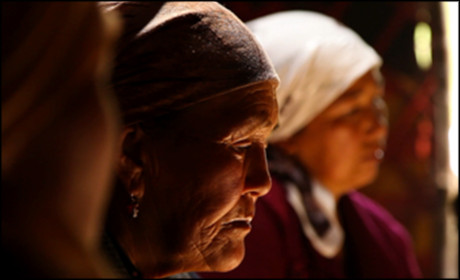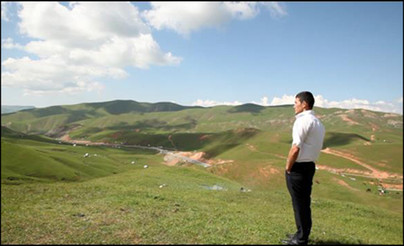
The ethnic violence in Kyrgyzstan of June 2010 scarred the country deeply, nowhere less so than in the southern city of Osh.
Gangs of Uzbek and Kyrgyz rioters stormed through the city, fighting each other in running battles or burning opposition homes – sometimes whole neighbourhoods – to the ground.
"We saw them overturn a car of Kyrgyz people, pull them out, dowse them in petrol and set them on fire," said 47-year-old Zuria, a Kyrgyz resident of Osh, speaking to the Guardian in 2011. "I was dressed like an Uzbek and speak the language. I convinced the crowd I was Uzbek and we were allowed to turn back."
Hundreds were killed and thousands of homes and buildings were destroyed. Now, three years later, BBC Central Asia Service has partnered with Storyscapes, a multimedia production company set up by ex-BBC correspondent Monica Whitlock and Dutch film foundation Dovana Films, to tell the story of the people of Osh.
"The challenges facing Osh are very similar to cities that have had ethnic or civic conflict all over the world," Whitlock told Journalism.co.uk. "So what we were trying to look at was not the point of view of the correspondent, or the aid worker, or the politician, but to look at the tiny things through which people construct their lives everyday.It's interesting to explore the internet as a medium rather than a vehicleMonica Whitlock, director, Storyscapes
"We wanted to peel apart the idea of what 'back to normal' means after civic conflict. It's an idea we use a lot in news, we say the city is 'back to normal'. But what does that mean?"
It is a tidy phrase for distant news organisations but, for many residents, there is no "back to normal". The loss of life and property has a permanent effect but, for some, it is the little things that make the difference. One woman would previously make "cheeky boys" on the bus give up their seat for her, but now feared doing so may cause an incident, said Whitlock.
"It was interesting and universally applicable to look at those tiny things because they're not particular to this one story," she said. "They speak more broadly to the human condition."
Having been the BBC's Central Asia correspondent for many years, Whitlock knows the region well and the content was collected on a week's trip with director Duco Tellegen last summer. On the Storyscapes site, the story of Osh is presented in three ways.
The most immediate are the "storyboards", laid out in five chapters, which give a mixture of selectable video, audio and photographic segments. These can be viewed in a running, linear format or taken individually, as snapshots into the lives of the city's residents or snippets of historical background.
"I think that for some time we've wanted to find a different way to tell stories," she said. "I mean 'we' in the broad sense; whenever we start to tell a story there is a certain limitation if you tell it in a linear way and you tend to have one person speaking from one side and one speaking from another side.
"That's fine but it's nice to see what the internet can do that is a bit more multi-faceted than that."
The idea of using the web's inherent versatility – of going beyond "just TV or radio that happens to be playing on a computer," said Whitlock – influenced the team's approach in making something that users could return to at intervals.

This is especially true of the second storytelling approach of the site – an explorable panoramic view of the city, taken from the Solomon's Throne hill. Pins are dotted around the landscape at relevant points, offering expandable videos that are geo-specific – businessman Isfandior's heartbreaking predicament as to whether to abandon his family home in the city centre; the border with Uzbekistan, just a few miles from the city, where many ethnic Uzbeks fled to at the height of the violence.
"For the panorama we were thinking about the way people use the internet nowadays," said Whitlock. "If you look at gaming then you're not always given instructions in a linear way. If you watch a bunch of kids using an immersive game its the immersive factor that pulls them on.
"It's interesting to explore the internet as a medium rather than a vehicle and we didn't label the panorama internally because that was the idea of immersion – that you don't know what you're going to uncover."
All of the video footage, images and audio is collected in the site's "library" along with papers and reports from NGOs or the international Kyrgyzstan Inquiry Commission, to add a greater background of depth and authority to the stories being told.
As with the site on the whole, the library is presented in three languages where possible – Kyrgyz, Uzbek and English – and the light construction and bite-size video clips means that everything is still accessible through a low bandwidth connection. In this way, Kyrgyz and Uzbek citizens can see the story of their healing city from both sides.
"All the way through we wanted to be empathetic rather than sympathetic. It's not supposed to be that you look at these people from afar and think 'Oh dear, how sad'," said Whitlock. "It should be something you can identify with and that's why we also chose stories that aren't finished. We have people on the horns of a dilemma deciding whether to leave the city or not."Everybody has been frustrated at one time or another by not being able to get the complex view that they want in their storyMonica Whitlock, director, Storyscapes
As well as a platform, Whitlock sees the Storyscapes site as a tool to potentially update the stories as time goes on, to create a "living archive" of material that will document the evolving nature of people's lives.
But the team, completed by programmer Paul Houthuijzen and film editor Luce van de Weg, sees further scope in the company's platform to create similar, documentary-style stories or quickly produced segments for breaking news stories for other news and media organisations.
"If people want them we can make them," said Whitlock. "It's much cheaper than making a standard documentary because a lot of the investment comes from us. The program has been developed so that's the time and money part. Going out and making the story is less expensive than making a conventional documentary as the team was only Duco and I. So it's very light on the pocket."
The story of Osh as told through Storyscapes has been an experiment not just in digital storytelling but in doing so in a globally accessible manner. Being able to tell stories that are complex and inclusive with multiple perspectives, said Whitlock, is precisely why such a multimedia platform is so effective.
"Everybody has been frustrated at one time or another by not being able to get the complex view that they want in their story, especially in a linear news film where they only get a few seconds.
"But we can present it differently. We'll put it out and we'll see."
Free daily newsletter
If you like our news and feature articles, you can sign up to receive our free daily (Mon-Fri) email newsletter (mobile friendly).
Related articles
- 200 speakers you need at your next journalism event to avoid all-male panels
- How Reuters, Newsquest and BBC experiment with generative AI
- Standing out in a crowded market: what makes a top news podcast?
- How can UK commercial local news media respond to BBC expansion?
- European broadcasters must address on-screen diversity









